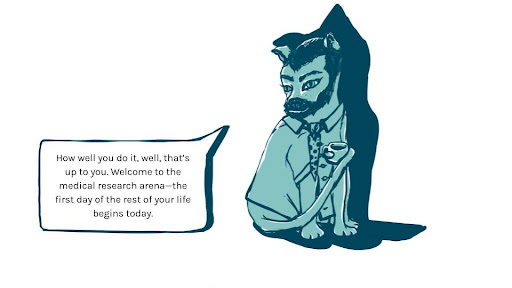The field of medical research copywriting isn’t quite as stringent as the field of medical practice itself. There are no surgical mishaps, no white coats, and, certainly, no life-threatening situations—though spending hours hunkered over the computer, eyes watering, as you thumb through a 20-page medical research paper will certainly be touch and go.
However, you will experience long hours, demanding clients, and pressure—a lot of it.
As a medical research copywriter, it’s your job to inform the public of a variety of medical developments with the precision and accuracy of a skilled surgeon. You must diagnose medical concerns, dissect controversial topics, amend previous statements, and your audience of how your client is a leader within the medical space.

Your Medical Research Copywriting Residency
Like Meredith Grey on her first day of residency, you’ve likely already honed your skills for years. But the fact is, medical research copywriters can come from a variety of educations and backgrounds—you don’t have to endure four years of med school to come out on top.
Perhaps you’re the daughter of a prodigal doctor, looking to live up to your mother’s medical prowess. Or maybe you’re a theater major looking to adopt a new role. No matter your reason, with enough diligence and hard work, you too can become a medical research copywriter.
Now, let’s scrub in.
Step One: Scrub In
When learning what is medical research copywriting and embarking on the medical research career path, it’s essential to prepare before you cut into the field. As such, many writers who chose medical copywriting careers will undergo a relevant education path. This may include:
- PhD in Medical Sciences
- MD in Family Medicine
- Bachelor of Science in Nursing
While a relevant professional background and medical credentials can be beneficial when dissecting large research papers or auditing scientific publications, it’s not essential. Any writer armed with a pen and an interest in medical education and research can become a medical research copywriter.
As a medical copywriter, there are several paths you can follow. The most common areas of medical writing include:
- Regulatory writing – This path is not particularly creative, but it does require resourcefulness. Regulatory writing involves writing and editing documents for regulatory agencies, such as the US Food and Drug Administration (FDA). A pharmaceutical or biotech company may also enlist your services to ensure their documents and sales materials are up to standard.
- Scientific publications – If you have a background in medical practice, you can work alongside other medical professionals and researchers to write and edit peer-reviewed scientific publications. While this is often thought of as a purely academic career, you may also have the opportunity to craft publications for medical device companies and other health care institutions looking to demonstrate their scientific expertise.
- Health communication – Health communicators craft informational resources for lay audiences, such as medical pamphlets, website content, news releases, and PR communications. As a health communicator, you may work for a publisher, media outlet, or health care institution.
- Education for professionals – These materials are geared toward physicians and health care professionals—in other words, the McDreamys and McSteamys of the world. Your work may include training materials, outcome analyses, and slide sets.
- Grantsmanship – As a grant writer, you’re essentially selling your organization’s value propositions and goals. As a scientific grant writer, you’ll be writing and editing grant proposals for scientific research funding for health institutions, private foundations, advocacy groups, and biotech start-ups—to name a few.
- Promotional writing – Ah, finally—promotional—that’s something we copywriters feel right at home with. Promotional medical communication will include marketing and advertising materials for diagnostic and therapeutic products, whether you’re announcing an innovative (and FDA-approved) insulin treatment or a new-and-improved CT scan that takes X-ray images to new heights.
Each sector will speak to a distinct audience within the medical space, whether it’s the general public or healthcare professionals.
As such, the language used and level of technicality will depend on the type of content you’re creating. While a grant proposal should be written in layman’s terms, training materials and outcome analyses should be more technical, since they’re geared toward medical experts.
Step Two: Sterilize
Perhaps one of the most important aspects of medical research copywriting is the research itself. Sure, you’ll need to craft concise and effective materials that follow a logical structure, but they must also be authoritative.
As such, you’ll need to sterilize your sources.
Draw from resources that are verified and factual, such as:
- Peer-reviewed journals and articles
- Scientific databases
- Evidence-based clinical reports
You’ll also need to familiarize yourself with medical literature, how research data is presented, the document review process, and editing and publishing requirements per regulation and compliance models.
Step Three: Put Your Audience Under

Each piece you publish as a medical copywriter should keep your audience informed and engaged (not anesthetized), whether you’re summarizing a clinical study or unveiling new technology.
Step Four: Make the Cut
After collecting authoritative and peer-reviewed scientific resources, you’ll need to formulate your medical research material so that it adheres to scientific writing principles.
While the format of your medical copywriting may differ depending on the client you’re writing for and the purpose the material serves, medical research materials are standardized in two ways.
#1 Scientific Knowledge Base
To ensure the material you’re producing meets regulatory and research standards, you must practice clear and accurate reporting. As such, you’ll need to understand the nuances and technicalities of the medical sector to convey your research effectively.
To that end, it may be beneficial to immerse yourself in the following domains:
- Medical and therapeutic knowledge – As a medical copywriter, you need to understand medical terminology and concepts. A basic knowledge set in various medical industries can help you write to specifics, rather than generalities.
- Drug processes and safety – Those working within the clinical development sector of medical copywriting should familiarize themselves with the drug development process and clinical research, as well as the guidelines and safety standards surrounding these practices.
- Statistics – Understanding statistics and knowing how to communicate them in a concise manner is essential to effective medical research copywriting. You’ll need to clearly communicate complex statistics in a way that makes it easy for qualified physicians and the general public to critically assess the quality and reliability of the study.
- Technical guidelines – If you’re writing for companies based in the US, EU, or Japan, you’ll need to follow a set of technical protocols called the International Conference on Harmonisation (ICH) guidelines), which are related to drug development and registration. These requirements lay the groundwork for those writing clinical study reports, investigator’s brochures, patient information pamphlets, clinical overviews, and safety reports.
#2 Writing Skills
In addition to demonstrating regulatory and clinical expertise, an effective medical copywriter must also communicate scientific information in a clear and comprehensible manner.
To that end, optimal medical copywriting content will:
- Adhere to language and grammar rules
- Follow logical organization and structure
- Be customized to its target audience and their familiarity with the subject matter
- Avoid highly complex medical jargon
- Utilize authentic sources from medical journals and databases
- Accurately interpret research data
- Present data in the form of graphs and charts
- Be truthful, transparent, and scientifically accurate
Step Five: Stop the Bleed
Quick—grab your most outstanding graphs and captivating vocabulary—you’re losing the audience!
Naturally, when writing about complex, scientific topics, you might feel as though your content is densely packed with facts and figures. However, as a copywriter, your job is to engage your audience—not lose them on the table. Luckily, you can stop the bleed with a few simple tricks:
- Always keep your audience in mind – When writing any sort of copywriting material, you must curate your content specifically to your intended audience in order to keep them hooked to your scientific siren songs. For example, if you’re writing a promotional pamphlet for a biotech company’s newest innovation, you’re courting medical professionals, private practices, and healthcare facilities. As such, you won’t want to harp on how futuristic and modern the technology looks. Instead, you’ll want to communicate the technology’s usability, versatility, and precision.
- Pay attention to structure – Like all storytelling, your content should have a clear beginning, middle, and end. Too much information at the beginning can ward off audience members, while too little in the middle may cause your audience to question your authority on the topic. Information overload can also cause your readers to flatline. As such, think logically about what you want to convey and how you can format your organization to touch on everything of importance.
- Use thought-provoking graphics – Finding an informational graphic among a wall of text is a lot like find a twenty-dollar bill in your pocket—exhilarating. Incorporating compelling or colorful charts, graphs, and other visual elements within your medical materials can increase your audience’s willingness to read your work by 80% and improve SEO strategy if you’re writing for an online outlet.
Step Six: Suture
You’ve done it—you’ve navigated a sea of scientific sources, curated your knowledge base, and wrote a compelling piece of content that engages your reader and exhibits you and your client’s medical expertise.
Now it’s time to tie up any loose ends with a clear, concise call to action. This is where you ask your audience, in the words of the aforementioned Dr. Grey, to pick me, choose me, love me.
It’s a staple of any marketing campaign that’s designed to:
- Provide important details about your client and their service or product
- Prompt an immediate response or sale
- Improve campaign outcomes of healthcare facilities and medical businesses
Pick Copycat, Choose Copycat, Love Copycat
Now with all that being said, if you’re looking for a medical copywriter, our writers here at Copycat are skilled at transforming technical research into compelling, comprehensive, and authoritative medical content.
With experience writing for medical professionals, rehab clinics, and CBD brands, we maintain HIPAA, HITECH, and FDA compliance to establish your brand as an authoritative expert in your field.
If you decide to sign the papers, we’ll be here.
Sources:
American Medical Writers Association. What Types of Medical Writing Are There? http://blog.amwa.org/what-types-of-medical-writing-are-there?
US National Library of Medicine. How to Become a Competent Medical Writer? https://www.ncbi.nlm.nih.gov/pmc/articles/PMC3149406/
HubSpot. 50 Visual Content Marketing Statistics You Should Know in 2021. https://blog.hubspot.com/marketing/visual-content-marketing-strategy

